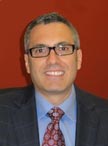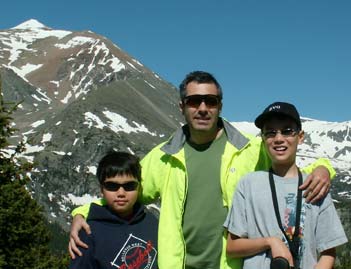Sunnybrook Surgeon-in-Chief Avery Nathens on
the University Trauma
Program

Avery Nathens
|
Avery Nathens spent the last
years of his training in General
Surgery at Sunnybrook, and has
a sense of belonging that stems
from that period. "Sunnybrook
is a very special place to me and
gave me my interest in trauma.
The move to Sunnybrook presented
an opportunity to take
the University's Trauma Program
to the next level, to build on
Robin Richards' work and to fulfill the academic mandate
of the Hospital. I have a strong interest in safety
and quality and the Centre for Patient Safety supported
by the hospital, the University and the Hospital for Sick
Children is well established at Sunnybrook. It is a great
opportunity to develop this focus for the Department
of Surgery.
"Sunnybrook has a very strong research institute,
with remarkable expertise in imaging. Imaging is so
essential to guide our interventions that this provides a
natural area for strong clinician-scientist collaboration.
In fact, many have developed strong relationships with
the imaging scientists to develop innovative strategies
ranging from better treatment of brain tumors to facial
reconstruction."
"Sunnybrook is remarkably pro-active in developing
partnerships, which fits my interest in systems of care.
Eighteen months ago, while I was trauma director at St.
Michael's, Homer Tien and I worked together in bringing
our two institutions closer together, leveraging our great
strengths - the transfusion work at Sunnybrook, and the
scorecards and protocols at St. Michael's Hospital for
example. We decided to build an integrated University
of Toronto program of Trauma care. We managed to
get support from the surgeons-in-chief and the hospital
programs to obtain administrative support to coordinate
our activities. Jim Wright then brought in The Hospital
for Sick Children. Now the standards, quality assurance,
and the safety protocols are uniform and well developed.
They have been harmonized in a way that makes interaction
with our external partners like EMS and Ornge
much more productive. We have worked together to
develop standardized inter-facility transfer protocols to
better support referring emergency medicine physicians.
We have developed a GTA Trauma Advisory Committee
with members representing the LHINS, Toronto EMS,
and the Emergency Medicine program to coordinate
activities across the spectrum of care. We've also developed
means to share data to improve the quality of
care. Probably one of the greatest benefits is the move
away from hospital-based fellowships to a "University
of Toronto Trauma Program" fellowship, with trainees
rotating between the trauma centres. We've recently
held our first University of Toronto Trauma Conference
at the BMO Institute with a focus on Mass Casualty
Planning, which will be critical as we head into the Pan
Am Games.
Probably one of the more exciting areas in the program
is our development of our website (http://surgery.
utoronto.ca/programs/trauma.htm) and the University
of Toronto trauma protocols. We have worked together
to standardize our care and made our care protocols
available on a mobile web site (m.trauma.utoronto.ca)
and apps available on both Android and Apple platforms.
To accomplish this, we used the expertise of our
residents, Marisa Louridas, Matt Strickland, and Balisi
Bakanisi, who we can't thank enough for moving this
project forward.
"Andy Smith has been a great support of this enterprise,
which fits perfectly with the Department's new
Strategic Plan, calling for greater integration across the
centres. We have found that the key driver to program
development was infrastructure support to provide
consistency. It is very difficult to move a program forward
when we are distracted by everyday crises. Having
one individual moving the program forward from the
administrative standpoint has been key. Tammy Kowalyk
has been remarkably effective in this role, coordinating
fellowships, developing the website and keeping her eye
on the bigger picture.

Avery Nathens with his two sons, Justin, 13 and Daniel, 16
|
Avery's role models were Ori Rotstein, who guided his
research and taught him how to give credit where credit
is due, and to build on the strength of the students, and
John Marshall. Both emphasized the axiom: "Do a few
things well". "My advice to residents is: Do a few things
very well and do the things that you love to do. When I
was in Seattle at Harborivew Medical Center, there was
a big focus on developing a bariatric program, an important
and emerging field at that that time. It was also a
potential revenue generator for the hospital. I made a
decision to not dilute my focus away from trauma in
spite of the pressures to do so. I counsel my residents and
surgical scientists to do what interests them and avoid
taking on activities that fill others' expectations or seen
to be required by circumstance."
Avery was a medical student at Queen's when he did
an elective with Bob Mustard, who inspired him to
go into surgery. "Bob is an extraordinary mentor. No
patient was every too sick and no problem too difficult.
I think of him as the MacGyver of surgery. (In a popular
television series, MacGyver was the ingenious scientist
who could solve complex problems using the simplest of
materials.) Bob was an ingenious doctor with a higher
calling. Bob went from mentor to one of my division
members at St. Michael's, where over 20 years later, he
continued to teach me about keeping patient's needs at
the top of mind. Ron Maier was perhaps my greatest
mentor from the trauma perspective. A chief of surgery
at Harborivew and a world-renowned trauma surgeon,
he taught me how to advocate for patients' out of the
hospital environment. His focus on the macro-level of
care was the inspiration for my interest in trauma systems.
In systems, small tweaks can have a huge impact
on the rates of injury, disability and death, far more than
one can have in the care of a single patient.
"Trauma surgery has evolved tremendously. Its heyday
was during the days of the crack cocaine epidemic in the
US, where there was a significant amount of penetrating
trauma. As the epidemic disappeared, we began
to care for more complex patients with blunt trauma,
many of whom were older. Less operative trauma meant
more time to focus on other aspects of emergency care.
We already had a culture of taking care of any and all
patients, regardless of insurance, regardless of the time of
day, so our move into Acute Care Surgery was natural.
It is also provided the opportunity to develop research
programs that focus on relatively common understudied
problems like appendicitis, cholecystitits, and diverticulitis.
The model of care for acute care surgery also lends
itself to an academic practice. When your "on", you have
no elective surgery and no clinics, which means you are
immediately available for quicker access to emergency
care for patients and improved hospital flow. The weeks
"off " provide ample opportunity for academic pursuits
or administrative work."
What has been the impact of trauma centres?
"It is better to think of these as trauma systems. The
systems are much more than a center - they involve
every hospital within a region as well as transportation
assets. Care in a trauma centre is associated with a 25%
reduction in the risk of death and an improvement in
functional outcomes. I have been fortunate to have the
opportunity to direct the American College of Surgeons
Quality Improvement program which benchmarks trauma
care across trauma centres. This program has made
it evident that there is wide spectrum of quality across
trauma centres. What makes for a high performing centre
is an intense area of study. The good news is that our
performance in Toronto is on par with the very best in
the United States."
What are your graduate students studying?
"All the students are working on projects related to either
injury or emergency general surgery. We have a wide
variety of collaborators in health systems, epidemiology,
public health and geography, which makes every day a
tremendous learning experience. "
Is there an ethics component in your specialty work?
"As an intensivist and trauma surgeon, I see such opportunities
for improvement. Care at the end of life is often
treated in a simplistic way: ‘inotropes – yes or no; intubate
– yes or no'. We teach the menu, but the big picture focus is
needed. I typically ask families to describe what their loved
one was like before they became critically ill. What made
them love life? What defined them as a person? These conversations
become so important as we establish the goals of
care for our sickest patients. It turns the conversation from
an a la carte menu to a patient focus and families tend to
be much more comfortable with their decisions.
Avery enjoys travelling with his boys, Justin, 13 and
Daniel, 16. He is an avid cyclist, hiker, runner and triathlete.
He lives with Lisa in a recently renovated 1903
Victorian home in Cabbagetown, a great enclave in the
middle of the city that is well known for its classic homes
and vibrant cast of characters.
M.M.
|